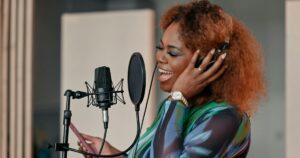Take the stress and slog out of recording audition self-tapes by sticking to these three simple rules.
Love them or loathe them, self-tapes are now the norm in the performing arts.
What started in response to the pandemic is now a firmly entrenched industry practice.
So no matter how daunting you find recording yourself, it’s a skill you must master if you want to ace drama school and musical theatre auditions.
To make this process easier, here are three nuggets of advice from performer, singing teacher and self-tape veteran Becca Luter.
1 Reframe how you think about self-tapes
Becca didn’t always enjoy making self-tapes.
“It’s something I’ve adapted to over time,” she says. “Initially, I would spend two hours in front of the camera doing about 20 to 30 takes. I’d overthink it.
“But the minute that you treat a self-tape as almost a real person audition, it allows you to be more comfortable.
“I know some people absolutely hate it and would just rather be in the room, but sometimes a self-tape is quite lovely.”
2 Only do three takes
While Becca used to do scores of takes, there are horror stories of performers doing hundreds to get things ‘just so’.
But how helpful or productive is it to do the same thing over and over again (and to beat yourself up when it’s not perfect)?
“Most of the time, even if you spent hours on a tape, you’d probably pick the first take,” Becca says.
Her advice is to limit yourself to only three takes but to have clear, defined intentions for each one.
“This allows you to look at it more logically and in a less self-critical way,” she says.
“For example, with my first take, I might do it as if I were in the room [with the casting agent]. Imagining that you’re within that audition space really helps.
“Then, with the second take, I usually go in with the intention of making things a bit smaller, just to see what it looks like on camera compared to what you would do in the room.
“With the third take, I would either completely change it up and have fun and see what comes creatively, or I would imagine I’m on the Coliseum stage and really command that space and give it a little bit more.”
You then have three very different takes to choose from. Remember, you’re trying to give the casting team an authentic insight into who you are as a performer. It’s not about achieving perfection.
3 Inject some personality into your intro
One of the main criticisms of self-tapes is that the performer can’t build a rapport with the casting panel.
But you can still give a glimpse of your personality when you introduce yourself at the beginning of the tape (the brief might also require you to answer a specific question).
“It’s a chance for the casting team to get a feel for you as a person, so be a normal human being – don’t be a robot,” Becca says.
Sometimes, performers are so focused on the song and dialogue elements of the process that they wind up going through the motions with their introduction.
Instead, think about how you would walk into an audition room and introduce yourself. Bring a bit of that spark to the start of your self-tape.
Learn more
Find out more about creating self-tapes by listening to our full-length interview with Becca on the Singing Teachers Talk podcast, where she also discusses:
- The tech you need to make a professional self-tape (don’t worry, you don’t have to spend a fortune).
- The dos and don’ts of editing a self-tape.




